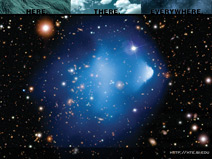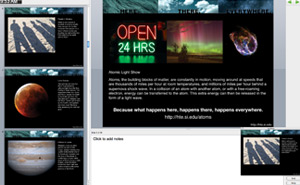


- MAKE YOUR OWN EXHIBIT
- WATCH A VIDEO
- READ A BLOG
- TACTILE & BRAILLE HTE
- AMERICAN SPACES
- PIN SOME IMAGES
- SHARE WITH A FRIEND

Topics: the shape of speed.
As a duck paddles across a pond, it creates ripples or waves that move out in front of it. If the duck paddles fast enough, the ripples will merge into a cone-shaped wall of water called a bow wave. Bow waves are
familiar sights in front of boats as well, and can also be formed in the atmosphere and in space when objects move more rapidly than the speed of waves in their liquid or gas environments.

- Swimmer.
- As this swimmer powers through the pool, each motion in her direction of progress pushes on the water. However, she is swimming faster than the waves can move away. The result is the build-up of a bow wave in the direction of her motion. If this wave were seen from above, it would have the shape of a "V."
- Image: REUTERS/Jean-Paul Pelissier
- Supersonic Jet.
- As an airplane moves through the air, it pushes on the air in front of it, creating sound waves. If the airplane is moving faster than the speed of sound, a bow shock is created. When this shock wave passes by our position on the ground, all of the sound waves that would have normally moved ahead of the plane are combined together so at first we hear nothing, and then we hear the boom created by the accumulated sound waves.
- Image: Stock Photography
- Merger of Galaxy Clusters.
- Galaxies are often found in large groups, called clusters, which are held together by gravity. The galaxies in clusters are immersed in huge clouds of multimillion-degree gas that produce X-rays. Here two clusters are merging together, with one cloud of gas plowing through a larger one at a supersonic speed. This creates sound waves that merge into a bow shock. The cone of increased pressure produced by the bow shock makes it detectable by an X-ray telescope.
- Image: X-ray: NASA/CXC/CfA/M.Markevitch et al.; Optical: NASA/STScI; Magellan/U. Arizona/D.Clowe et al
Where can bow shocks exist?
In the water, the air, or in space, anywhere that an object moves rapidly enough through
the surrounding liquid or gas.
Related Resources

"Here, There, & Everywhere" (HTE) is supported by the National Aeronautics and Space Administration under grant NNX11AH28G issued through the Science Mission Directorate.
HTE was developed by the Chandra X-ray Center, at the Smithsonian Astrophysical Observatory, in Cambridge, MA.
Email: cxcpub@cfa.harvard.edu | Phone: 617.496.7941
Follow us: #HTEScience on Twitter





